The main question is contained in the experiment #6. But first, 5 simple experiments are described to describe the designations that are used in the question of the experiment #6.
In the double-slit experiment, the slits are labeled α and β. A region C is designated on the screen. The power passes through the open slit: ${P_\alpha} = {P_\beta} = {P_{\rm{sl}}}$
Experiment #1: Both slits are open, and the screen is a flat solid surface. This is well described and shown in the diagram (which is taken from here). The total power of light on the screen is ${P_{\rm{scr 1}}} = {P_\alpha} + {P_\beta} = 2 \cdot {P_{\rm{sl}}}$. The power of light outside the region C is ${P_{{\rm{scr}} - {\rm{C }}1}} = {P_{{\rm{scr }}1}} - {P_{{\rm{C }}1}} = 2 \cdot {P_{{\rm{sl}}}} - {P_{{\rm{C }}1}}$.
Experiment #2: Slit α is open. Slit β is closed. The total power of light on the screen is ${P_{{\rm{scr 2}}}} = {P_\alpha } = {P_{{\rm{sl}}}}$. The power of light outside the region C is ${P_{{\rm{scr}} - {\rm{C }}2}} = {P_{{\rm{scr }}2}} - {P_{{\rm{C }}2}} = {P_{{\rm{sl}}}} - {P_{{\rm{C }}2}}$.
Experiment #3: Slit β is open. Slit α is closed. The total power of light on the screen is ${P_{{\rm{scr 3}}}} = {P_\beta } = {P_{{\rm{sl}}}}$. The power of light outside the region C is ${P_{{\rm{scr}} - {\rm{C }}3}} = {P_{{\rm{scr }}3}} - {P_{{\rm{C }}3}} = {P_{{\rm{sl}}}} - {P_{{\rm{C }}3}}$.
Considering symmetry, the index 23 is added: $${P_{{\rm{C }}2}} = {P_{{\rm{C }}3}} = {P_{{\rm{C 2}}3}} \Rightarrow {P_{{\rm{scr}} - {\rm{C }}2}} = {P_{{\rm{scr}} - {\rm{C }}3}} = {P_{{\rm{scr}} - {\rm{C 2}}3}}$$
In Experiment #1, the power of light in the region C is greater than the sum in Experiments #2 and #3. Therefore, the power of the rest of the screen is less: $${P_{{\rm{C }}1}} > 2{P_{{\rm{C 2}}3}} \Rightarrow {P_{{\rm{scr}} - {\rm{C }}1}} < 2{P_{{\rm{scr}} - {\rm{C 2}}3}}$$
Next, the conical pit with A and B is made in the screen within the region C, as shown in the next diagram. The region A sees slit α and does not see slit β. The region B sees slit β and does not see slit α. This means that a straight ray from A falls on α, but not on β. A straight ray from B falls on β, but not on α. Because the angle between A and B is less than the angle between the straight rays from the slit α and β to the screen centre, as shown in the next diagram. Diffraction at the edges of the transition from regions A and B to the flat screen is neglected, assuming the region C size is much larger than the wavelength.
The experiments #4 and #5 are repeated experiments #2 and #3 with the new screen. The power in the regions A and B can be easily determined: $${P_{{\rm{A }}4}} = {P_{{\rm{{C} }}2}} = {P_{{\rm{{C} }}23}}$$ $${P_{{\rm{B }}4}} = 0$$ $${P_{{\rm{A }}5}} = 0$$ $${P_{{\rm{B }}5}} = {P_{{\rm{{C} }}3}} = {P_{{\rm{{C} }}23}}$$ $${P_{{\rm{A }}4}} + {P_{{\rm{B }}4}} + {P_{{\rm{A }}5}} + {P_{{\rm{B }}5}} < {P_{{\rm{C }}1}}$$ $${P_{{\rm{scr}} - \left( {{\rm{A}} + {\rm{B}}} \right){\rm{ }}4}} = {P_{{\rm{scr}} - {\rm{{C} }}2}} = {P_{{\rm{scr}} - {\rm{{C} }}23}}$$ $${P_{{\rm{scr}} - \left( {{\rm{A}} + {\rm{B}}} \right){\rm{ }}5}} = {P_{{\rm{scr}} - {\rm{{C} }}3}} = {P_{{\rm{scr}} - {\rm{{C} }}23}}$$
Experiment #6: Both slits are open, and there is the conical pit in the screen. What will be the power in the regions A and B? What will be the power in the the rest of the screen? Is there the right inequality (1) or (2) or something else?
The conservation of energy requires: $${P_{{\rm{A }}6}} + {P_{{\rm{B }}6}} + {P_{{\rm{scr}} - {\rm{{C} }}6}} = {P_{{\rm{scr 6}}}} = {P_\alpha } + {P_\beta } = 2 \cdot {P_{{\rm{sl}}}}$$
If the power outside the region C corresponds to Experiment #1, then the power in the regions A and B must change and become greater than in Experiments #4 and #5: $${P_{{\rm{scr}} - {\rm{{C} }}6}} = {P_{{\rm{scr}} - {\rm{{C} }}1}}$$ $${P_{{\rm{A }}6}} + {P_{{\rm{B }}6}} = {P_{{\rm{scr 6}}}} - {P_{{\rm{scr}} - {\rm{{C} }}6}} = 2 \cdot {P_{{\rm{sl}}}} - {P_{{\rm{scr}} - {\rm{{C} }}1}} = {P_{{\rm{C }}1}} > 2{P_{{\rm{C 2}}3}} = {P_{{\rm{A }}4}} + {P_{{\rm{B }}4}} + {P_{{\rm{A }}5}} + {P_{{\rm{B }}5}}$$ $$ \left\{ \begin{array}{l} {P_{{\rm{scr}} - {\rm{{C} }}6}} = {P_{{\rm{scr}} - {\rm{{C} }}1}}\\ {P_{{\rm{A }}6}} + {P_{{\rm{B }}6}} > 2{P_{{\rm{C 2}}3}} \end{array} \right. \qquad(1) $$
But straight ray from each of the slit falls on only one corresponding region. Each of the regions sees only one corresponding slit. How can the power on it depend on whether the second slit is open or closed? "If light propagates like waves, why can't I see around corners?" and "Can light beams (e.g. from a laser) visibly interfere if they cross in mid-air?" are related questions.
And if the power in the regions A and B remains the same as in Experiments #4 and #5, then the power of the rest of the screen must change and become greater than in Experiment #1: $${P_{{\rm{A }}6}} + {P_{{\rm{B }}6}} = {P_{{\rm{A }}4}} + {P_{{\rm{B }}4}} + {P_{{\rm{A }}5}} + {P_{{\rm{B }}5}} = 2{P_{{\rm{C 2}}3}}$$ $${P_{{\rm{scr}} - {\rm{{C} }}6}} = {P_{{\rm{scr 6}}}} - \left( {{P_{{\rm{A }}6}} + {P_{{\rm{B }}6}}} \right) = 2 \cdot {P_{{\rm{sl}}}} - 2{P_{{\rm{C 2}}3}} = 2{P_{{\rm{scr}} - {\rm{{C} }}23}} > {P_{{\rm{scr}} - {\rm{{C} }}1}}\\$$ $$ \left\{ \begin{array}{l} {P_{{\rm{scr}} - {\rm{{C} }}6}} > {P_{{\rm{scr}} - {\rm{{C} }}1}}\\ {P_{{\rm{A }}6}} + {P_{{\rm{B }}6}} = 2{P_{{\rm{C 2}}3}} \end{array} \right. \qquad(2) $$ But how can the power on the rest of the screen change due to the appearance of pits in it?
In this closely related question “ Young's double slits with a hole in the screen (Wheeler observer) ”, the power is not considered and screen shapes is other. Also, judging by the lack of a comprehensive answer, the question remains underestimated. Although the experiment is very simple from a practical point of view. Presumably, it has already been conducted and has explanations of the results... but where?

